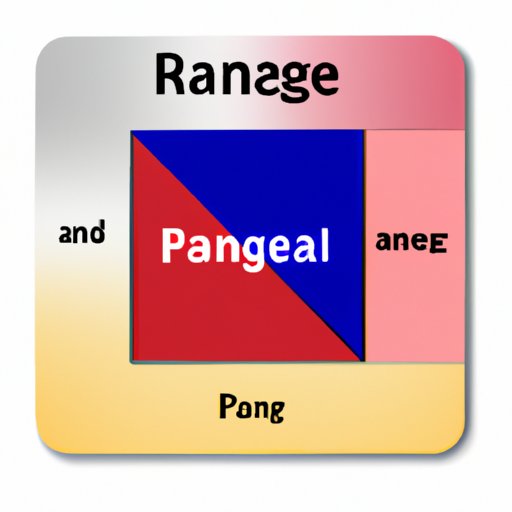I. Introduction
Do you want to learn how to calculate range in statistics? You have come to the right place. In this article, we will provide a step-by-step guide, explain the importance of range, teach you to use technology for calculation, and compare range with other measures of central tendency. Finally, we will test your knowledge with an interactive quiz. By the end of the article, you will be able to apply the concepts learned to your own data analysis.
Before we dive in, let’s define what range is in statistics.
II. A Step-by-Step Guide to Calculating Range
First, we must define range.
Range: the difference between the maximum and minimum values in a dataset.
Now let’s break down the steps needed to calculate range.
- Identify the minimum value in the dataset.
- Identify the maximum value in the dataset.
- Subtract the minimum value from the maximum value to find the range.
Let’s work through an example problem step-by-step to help illustrate the concept.
Suppose we want to calculate the range of the following dataset: 7, 12, 8, 15, 10.
- The minimum value in the dataset is 7.
- The maximum value in the dataset is 15.
- Subtract the minimum value from the maximum value to find the range: 15 – 7 = 8.
The range of the dataset is 8.
Here are some tips and tricks to make the process easier:
- Make sure to order the dataset from smallest to largest before identifying the minimum and maximum values.
- You can use a formula in Microsoft Excel or Google Sheets to automatically calculate the range.
III. Explaining the Importance of Range in Statistics
In statistics, range is an important measure of variability.
Variability: the extent to which the values in a dataset differ from each other.
Range gives us an idea of how spread out the values are in a dataset. It is helpful when analyzing data because it helps us to identify outliers and the spread of the data.
For example, suppose we are conducting a study to analyze the test scores of two classes. Class A has a range of 35 points, while Class B has a range of 5 points. This tells us that the scores in Class B are more tightly clustered around the mean than the scores in Class A. If we were to only look at the mean scores of the two classes, we would miss this important difference in variability.
IV. Using Technology to Calculate Range
Calculating range by hand can be time-consuming. Fortunately, there are several technologies available to make the process easier and more efficient.
One option is to use a spreadsheet program such as Microsoft Excel or Google Sheets. Simply enter the dataset into the program, select the cell where you want to calculate the range, and use the formula =MAX(dataset)-MIN(dataset).
Another option is to use a statistical software program such as SPSS or SAS, which can not only calculate range but also provide more advanced data analysis options.
Here are some tips for effectively using technology to calculate range:
- Make sure to double-check your input to avoid errors.
- Take advantage of the software’s features to perform more advanced analyses.
- Be aware of the limitations of the software and be prepared to perform manual calculations if necessary.
V. When to Use Range and When to Use Other Measures of Central Tendency
Range is not the only measure of central tendency available in statistics. Other measures include mean, median, and mode.
Mean: the average value of a dataset.
Median: the middle value of a dataset when the values are ordered from smallest to largest.
Mode: the value that appears most frequently in a dataset.
So, when should we use range over these other measures?
Range is most useful when we need to get a sense of how spread out the dataset is, or when we need to identify outliers. Mean, median, and mode are more commonly used to describe the central tendency of a dataset.
Here are some examples to illustrate how to choose the appropriate measure of central tendency:
- Suppose we are conducting a study to analyze the heights of students in a class. In this case, we would use mean height to describe the central tendency of the dataset.
- Suppose we are analyzing the salaries of employees in a company. In this case, we would use range to get a sense of how much the salaries vary between employees.
VI. Interactive Quiz to Test Your Range Calculation Skills
Now it’s time to put your knowledge to the test with an interactive quiz! Here’s how it works:
- You will be presented with a question related to range calculation.
- You will choose the best answer from a list of multiple-choice options.
- Immediate feedback and explanations will be provided for each question.
Ready to get started? Click here to access the quiz!
VII. Conclusion
Now you know how to calculate range in statistics, why it is important in data analysis, how to use technology to calculate range, when to use range, and when to use other measures of central tendency. Congrats!
Range is a key measure of variability that offers insights into how spread out values are in a dataset. It can help us identify outliers and draw important conclusions in our research.
We hope you enjoyed this article and that you are ready to try out what you learned on your own data analysis.
